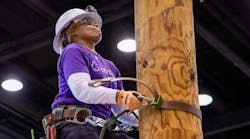Curiosity and tenacity have helped Ed Hunt become one of the go-to people for lineman safety standards, but his journey started by accident. In 1983, as a 23-year-old applicant for a groundman position with the city of Longmont, Colorado, U.S., Hunt thought he was applying to mow lawns at city parks. Once on the job, he discovered how wrong he was, but he also discovered the job suited him. After finishing an apprentice program and becoming a journeyman lineman, he joined Western Area Power Administration in 1992.
“It was the best move I ever made,” he said.
But his luck didn’t stop there. While attending an industry conference in 1996, he struck up a conversation with a member of the IEEE Transmission & Distribution Committee who was looking for new committee members. She asked him to serve on the IEEE Electrical, Safety and Maintenance of Lines Group, and he subsequently received permission from Western to do so.
Four years later, his curiosity and tenacity helped him take a lead in live work safety. While out with his crew, Hunt, a foreman II at the time, noticed polymer insulators in a deadend configuration and wondered what Western’s rules said about testing polymer deadend insulators before barehanding them.
“It got my wheels spinning,” Hunt said. He consulted with people at IEEE and EPRI, but no one on the Electrical, Safety and Maintenance of Lines Group of the IEEE or on the EPRI Live Working Task Force he also served on seemed concerned about it, he said. Convinced that crews should have to test polymer insulators, he wrote an article for T&D World on the topic.
“Boy did that stir up a hornet’s nest,” Hunt said. “I was getting calls from some big utilities asking, ‘What do you mean we shouldn’t be working these things energized?’”
Over time, consensus grew that Hunt was onto something. He initially proposed a shunt to solve the problem.
“It was my lineman logic way of going about it,” Hunt said. “It was a crude device that we built to clip onto the polymer with a hot stick to shunt out a portion of that. My thought was that if you shunt out a portion of a polymer, it would be the same as shorting out a chunk of insulation as you came in to barehand it.”
The idea did not pan out, but it spurred ideas by others in the industry, including his EPRI working group. Around 2003, Andrew Phillips, an EPRI engineer, created a proof-of-concept tester made out of PVC. That model led to an EPRI-created field-ready tester. In 2012, EPRI distributed 10 of these units to utilities to test. Since then, EPRI has licensed Hubbell to commercialize the devices.
In 2006, the development of this tool resulted in Hunt, Allan Holloman at Southern Co. and John Kile at Tennessee Valley Authority receiving the EPRI Technology Transfer Award, which is given annually for projects that take research and apply them in the field.
Hunt would like to think his work on the polymer insulator tester has helped improve safety for transmission linemen, but until the tester is commercialized, its use is limited, he said. So far, no standard requires testing of polymer insulators, even though Hunt’s IEEE committee is working toward writing a paper on the topic that eventually could be wrapped into a guide.
The ability to help the industry is part of the reason Hunt continues working on his IEEE and EPRI committees, despite being on the road 35 to 40 weeks each year. Since the recession, fewer utilities allow employees to serve on industry committees, meaning that more of the committee positions are being filled by contracting companies, Hunt said.
Utilities and contractors are both essential to the industry, but utilities own the system, which Hunt said means utilities should take the lead in setting standards.
“Contractors are simply coming in to work on the system,” Hunt said. “You’d think the utility would be very interested in making sure that if contractors are coming in that they are working under the best safety procedure.”
Regardless of who serves on committees, long-term commitment to those committees also has waned, with new people coming and going often, he said. That lack of continuity in committee member participation is a negative, Hunt added.
“You don’t write a standard in a year,” Hunt said. A lot can change during the 10 years a standard is in place before its required update. It takes years of committee experience before members become comfortable with the standards process. He admits that even after more than 15 years on the committee, he is still learning the process.
However, after 30 years in the business and the past 15 developing and updating standards from fall protection to conductive clothing, Hunt definitely knows more than he did when he was 23 years old and thought that a groundman job involved using a lawn mower.


